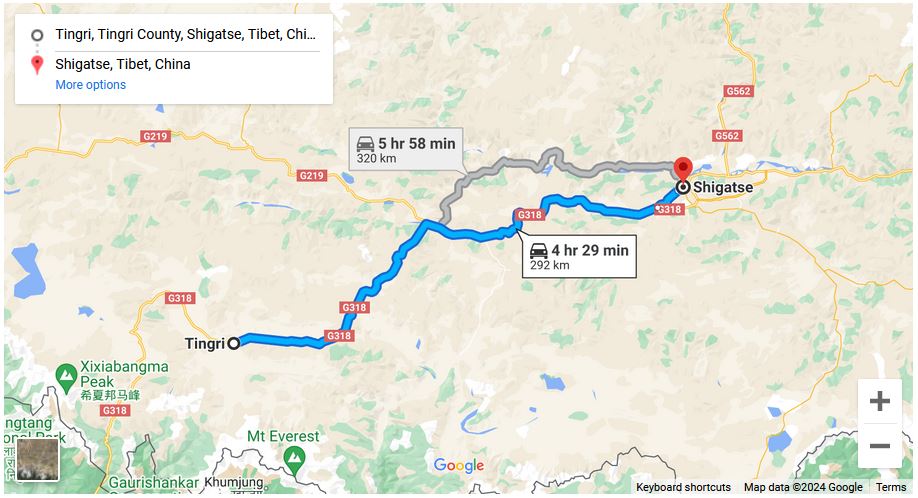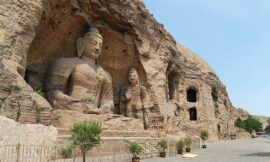The trek from Tingri to Shigatse unfolds as a mesmerizing journey through the vast expanses of the Tibetan Plateau, revealing the unique landscapes, traditional Tibetan settlements, and the cultural heritage of this high-altitude region. As travelers leave the tranquil plains surrounding Tingri, they embark on a road journey that traverses the rugged terrains, nomadic landscapes, and eventually leads to the vibrant city of Shigatse.
Tingri, situated at an elevation of around 4,300 meters, provides a serene and picturesque setting amidst the rolling hills of the Tibetan Plateau. Travelers often use Tingri as a base for acclimatization before venturing into the higher elevations of the Everest region. As they depart Tingri, the road stretches across the expansive plateaus, revealing the stark beauty of the high-altitude plains.
The Friendship Highway continues to wind its way through the Tibetan Plateau, offering panoramic views of snow-capped peaks and vast grasslands. Nomadic settlements with their traditional black tents and herds of yaks provide glimpses into the nomadic way of life that has been sustained for generations in this harsh environment. The road gradually ascends, reaching elevations that command awe-inspiring vistas of the surrounding Himalayan ranges.
En route to Shigatse, travelers often encounter the shimmering waters of Yamdrok Lake, one of the three largest sacred lakes in Tibet. The turquoise lake is framed by snow-capped peaks and surrounded by prayer flags, creating a breathtaking spectacle against the Tibetan Plateau’s vast backdrop. Yamdrok Lake is considered a sacred site, and its crystal-clear waters add a touch of tranquility to the journey.
As the journey continues, the landscapes shift from nomadic plains to cultivated fields, and traditional Tibetan villages come into view. The road passes through Gyantse, a historic town that houses the Pelkor Chode Monastery and the iconic Kumbum Stupa. The monastery, with its stunning murals and intricate sculptures, reflects the rich religious and cultural heritage of Tibet.
Shigatse, the second-largest city in Tibet, serves as the final destination for this leg of the journey. Situated at an elevation of around 3,800 meters, Shigatse is a bustling city with a mix of modern developments and traditional Tibetan architecture. The city is renowned for the Tashilhunpo Monastery, one of the six major monasteries of the Gelug school of Tibetan Buddhism.
The Tashilhunpo Monastery, with its golden roofs and impressive structures, stands as a testament to Tibet’s spiritual and cultural legacy. Travelers exploring the monastery encounter ancient prayer halls, towering statues, and the vibrant colors of Tibetan Buddhist art. The monastery also houses the Panchen Lama’s residence, adding to its historical and religious significance.
Shigatse offers travelers a blend of cultural exploration and modern amenities. The city’s markets are filled with Tibetan handicrafts, thangka paintings, and traditional Tibetan attire. Travelers can stroll through the streets, interact with locals, and immerse themselves in the vibrant tapestry of Tibetan daily life.
Accommodations in Shigatse cater to a range of preferences, from traditional Tibetan-style guesthouses to more modern hotels. The city’s diverse culinary scene allows travelers to savor Tibetan dishes and experience the unique flavors of the region.
In conclusion, the journey from Tingri to Shigatse is a captivating passage through the Tibetan Plateau, offering travelers a blend of natural beauty, nomadic landscapes, and cultural exploration. From the plains surrounding Tingri to the sacred waters of Yamdrok Lake and the historic town of Gyantse, the route provides a diverse and immersive experience. Shigatse, with its bustling energy and cultural richness, stands as a fitting conclusion to this leg of the trans-Himalayan adventure, inviting travelers to further explore the treasures of Tibet.



